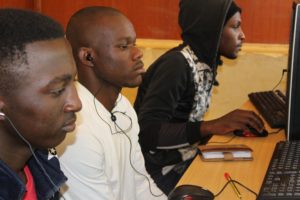Testing Digital Inclusion in Kenya
Read about our top findings from our year-long Digital Life: Kenya project, piloting the use of Learn My Way by the Kenya National Library Service.
It’s been an intense first year of our Kenya pilot, and we’ve learnt a lot about digital inclusion in Kenya. Here are our top three findings.
- Learners and librarians are benefitting from Learn My Way but the content needs to be more tailored to a Kenyan audience. Although Learn My Way has been designed for people with a reading age of 8, there are people living in the most rural parts of Kenya who cannot speak English at all, and therefore have struggled. In the UK, our Online Centres use Learn My Way and face to face support to help people navigate the internet, including helping them search for jobs and interact with government services online. However, the systems that these things sit in are very different from country to country. As do people’s motivations for going online.
- We’ve supported over 1,000 learners with basic digital skills, but we aren’t currently reaching the most socially and digitally excluded people in Kenya. We have had a great year working with Kenya National Library Service (knls) and 62 libraries to take basic digital skills training to more people in Kenya. So far approximately 70% of the people the libraries have supported have been men, nearly 60% are under 25, and two-thirds had been on the internet before they used Learn My Way, and could already do things on the internet. And of course, these are the people who can afford to pay 20 Kenyan Shillings a day to use the internet at libraries. They are the people who know where the library is and have the confidence to go in. During the pilot, we’ve met other organisations working in digital literacy and social inclusion like independent NGOs, resource centres and empowerment centres. The question is, what else can we do to reach people who don’t currently go to libraries?
- Network management and advocacy are two of the key strengths of Good Things Foundation, but this is more difficult to do when working at a distance. The pilot was supported by a small team in the UK, working with two members of the knls team in Nairobi. We made two visits and had monthly calls with knls, but faced challenges in communicating with and designing suitable support for them along the way. We also struggled to do research – both in Kenya and at a distance. Even by taking time to understand Kenyan culture, we faced challenges in gathering honest feedback. This is why we worked with the Kenya-based Tunapanda Institute to:
- Understand how people in libraries are currently using Learn My Way, including details of any support they are receiving
- Assess how Learn My Way is benefitting people in Kenya and learn when it is not
- Evaluate whether additional country-specific learning content for Kenya would be beneficial.

Tunapanda’s research confirmed to us that we are not reaching our target audience – yet. More outreach activities and local marketing is needed to get people thinking about how digital inclusion can benefit their lives. There are other venues and networks we could work with, and localised content for Learn My Way is needed.
Other findings from year one of the pilot
Motivation
- Libraries in Kenya (and Learn My Way) are mainly used by young people to support their formal education. They are motivated by employment and earning money.
- Some people use computers in libraries to earn money, using digital platforms that serve up micro pieces of work such as transcribing.
- Government services are going online, and more and more people are coming to the libraries to engage with eGovernment services.

Barriers to learning
- Education is a divider in Kenya. Those who go to school get taught in English and a lack of English is a barrier to engaging with libraries and learning digital skills.
- A lot of people are busy earning money, often so little that they have to spend it on domestic duties, and don’t have the time to learn.
- Basic literacy is a barrier for many adults, even in Swahili.
Delivery challenges
- Stable internet connectivity is a problem for all libraries.
- Some librarians find it hard to advocate the benefits of digital to others and supporting digital skills adds to their workload.
The good news
We know that digital has the potential to help people earn money online, gain skills for employment, learn farming techniques and find land information – all of which are things that are potentially very useful to our Kenyan audience.
We’ve also learned that people want to know what to do next after they’ve used Learn My Way. Providing progression routes will add value for the people who are keen to learn more.
What next?
There’s a lot we still don’t know. So we are pleased to announce that our Digital Life: Kenya pilot will be continuing for another year, so we can find out even more, and test some of the recommendations coming out of year one. Ideas for next year include:
- Expanding our network of community partners beyond libraries to see if we can reach more people.
- Co-designing approaches to teaching people basic digital skills in Kenya, through Learn My Way and other learning resources.
- Working more closely with people or organisations on the ground in Kenya.
As Good Things Foundation move increasingly into working in developing countries, it’s crucial that we test and shape our model based on evidence and real-life experience. The Digital Life: Kenya pilot is helping us do just that, providing the evidence we need to design effective interventions that will help us become a truly global organisation.
Follow the pilot as it progresses, or get in touch with emily.redmond@goodthingsfoundation.org to find out more.
